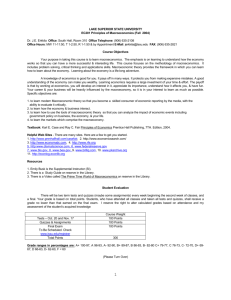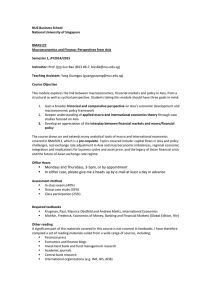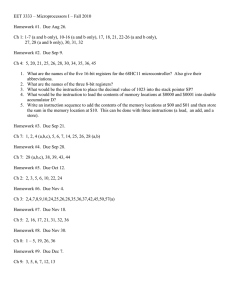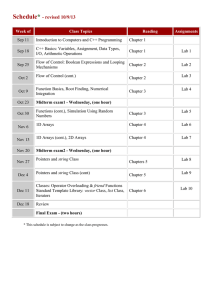LAKE SUPERIOR STATE UNIVERSITY EC201 Principles of Macroeconomics (Fall 2004)
advertisement
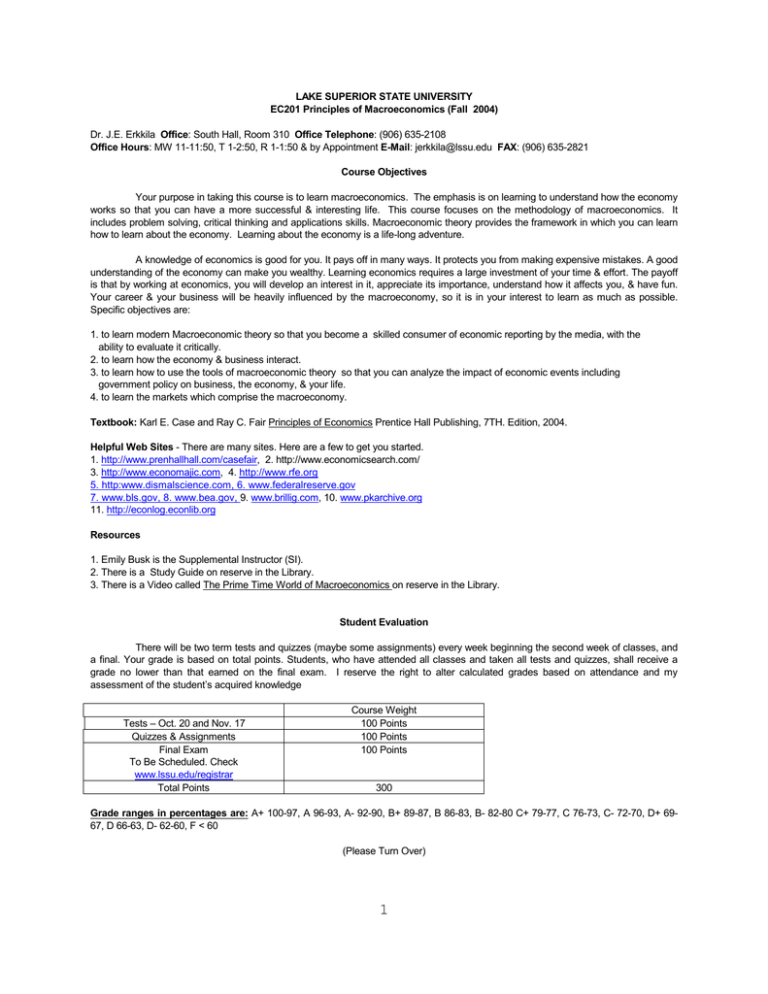
LAKE SUPERIOR STATE UNIVERSITY EC201 Principles of Macroeconomics (Fall 2004) Dr. J.E. Erkkila Office: South Hall, Room 310 Office Telephone: (906) 635-2108 Office Hours: MW 11-11:50, T 1-2:50, R 1-1:50 & by Appointment E-Mail: jerkkila@lssu.edu FAX: (906) 635-2821 Course Objectives Your purpose in taking this course is to learn macroeconomics. The emphasis is on learning to understand how the economy works so that you can have a more successful & interesting life. This course focuses on the methodology of macroeconomics. It includes problem solving, critical thinking and applications skills. Macroeconomic theory provides the framework in which you can learn how to learn about the economy. Learning about the economy is a life-long adventure. A knowledge of economics is good for you. It pays off in many ways. It protects you from making expensive mistakes. A good understanding of the economy can make you wealthy. Learning economics requires a large investment of your time & effort. The payoff is that by working at economics, you will develop an interest in it, appreciate its importance, understand how it affects you, & have fun. Your career & your business will be heavily influenced by the macroeconomy, so it is in your interest to learn as much as possible. Specific objectives are: 1. to learn modern Macroeconomic theory so that you become a skilled consumer of economic reporting by the media, with the ability to evaluate it critically. 2. to learn how the economy & business interact. 3. to learn how to use the tools of macroeconomic theory so that you can analyze the impact of economic events including government policy on business, the economy, & your life. 4. to learn the markets which comprise the macroeconomy. Textbook: Karl E. Case and Ray C. Fair Principles of Economics Prentice Hall Publishing, 7TH. Edition, 2004. Helpful Web Sites - There are many sites. Here are a few to get you started. 1. http://www.prenhallhall.com/casefair, 2. http://www.economicsearch.com/ 3. http://www.economajic.com, 4. http://www.rfe.org 5. http:www.dismalscience.com, 6. www.federalreserve.gov 7. www.bls.gov, 8. www.bea.gov, 9. www.brillig.com, 10. www.pkarchive.org 11. http://econlog.econlib.org Resources 1. Emily Busk is the Supplemental Instructor (SI). 2. There is a Study Guide on reserve in the Library. 3. There is a Video called The Prime Time World of Macroeconomics on reserve in the Library. Student Evaluation There will be two term tests and quizzes (maybe some assignments) every week beginning the second week of classes, and a final. Your grade is based on total points. Students, who have attended all classes and taken all tests and quizzes, shall receive a grade no lower than that earned on the final exam. I reserve the right to alter calculated grades based on attendance and my assessment of the student’s acquired knowledge Tests – Oct. 20 and Nov. 17 Quizzes & Assignments Final Exam To Be Scheduled. Check www.lssu.edu/registrar Total Points Course Weight 100 Points 100 Points 100 Points 300 Grade ranges in percentages are: A+ 100-97, A 96-93, A- 92-90, B+ 89-87, B 86-83, B- 82-80 C+ 79-77, C 76-73, C- 72-70, D+ 6967, D 66-63, D- 62-60, F < 60 (Please Turn Over) 1 Make-Up Policy The University policy is to allow students who are excused from class by a University Vice-President to make-up missed work. .However, students are not excused from being prepared. For others, If you let me know in advance i.e. 24 hours., I willl do my best to accommodate you but no promises. Extra Work Policy There are no extra work assignments. Attendance Policy I have one rule – DO NOT MISS ANY CLASSES. Attendance is taken every day. Research shows that grades and attendance are positively correlated. Put simply, if you do not attend class, you should not expect to pass. . As adults, you are free to make your own choices but you must also be prepared to accept the consequences. Disability Statement In compliance with Lake Superior State University policy and equal access laws, disability-related accommodations or services are available. Students who desire such services are to meet with the professor in a timely manner, preferably the first week of class, to discuss their disability-related needs. Students will not receive services until they register with the Resource Center for Students with Disabilities (RCSD). Proper registration will enable the RCSD to verify the disability and determine reasonable academic accommodations. RCSD is located in Library 101. The telephone number is 635-2454. State Standards met by this course 1.4 describe how government decisions on taxation and spending impact what is produced, how it is produced, and who receives the benefit of production. 3.1 acquire information from books, maps, newspapers, data sets, and other sources; organize and present the information in maps, graphs, charts, and time lines; interpret the meaning and significance of information; and use a variety of information; and use a variety of electronic technologies to assist in assessing managing information 2 Course Schedule Schedule is Tentative & Subject to Change (No Classes on Sep. 6 and 7- Labor Day, Nov. 24 and Nov. 26 - Thanksgiving) DATE Aug. 30 Sep. 1, 3 Sep. 8, 10, 13, 15 Sep. 17, 20, 22, ASSIGNMENT Ch 1 (Brief Survey), Ch. 2, Omit pp. 25 to top of 28. Business Cycle Graph p. 386 GDP p. 391, Graph. p.387, Table p. 637 Inflation p. 379, Graph p. 388, Table p. 424 Unemployment Rate p. 415, Graph. p. 388, Table p. 416 (Participation Rate p. 415, Graph p.616, Table 416) Interest Rate p. 499, p. 512-3 Gov’t Budget p. 464, Graphs pp. 465-6, 589-9 Table p. 582 Productivity 412, Graph p. 412, Table p. 634 & 638 Exchange Rate Balance of Trade 666, Table p. 666 Ch 3 TOPIC(S) Introduction to Macro. Definition of Macro Aggregates, Business Cycle p. 386. Production Possibility Frontier, Economic Growth Ch. 22 What Is Money? pp 475-77. Money Measurement. pp 477-9. Money Creation pp. 479-85 Federal Reserve System pp. 485-9 Control of Money Supply pp. 489-95 Demand for Money pp. 499-506 Interest Rate Determination pp. 506-9 Fed. Policy p. 509 Exchange Rate Determination The Great Depression, Economic Goals, GDP, Labor Market, Inflation, Productivity Sep. 24, 27 Ch. 23 Sep. 29, Oct. 1 Oct. 4, 6, 8, 11, 13 pp. 696-702 Chs. 17, 18, 19 Consumption Graph p. 615 Housing Investment Graph p. 616 Plant & Equipment Investment Graph p. 622 Inventory Investment Graph p. 623 Ch. 20 Oct. 15, 18 Oct. 20 Oct. 22, 25, 27, 29 Nov. 1, 3, 5, 8 Nov. 10, 13, 15 Nov. 17 Nov. 19, 22, 29, Dec. 1, 3 Test 1 Ch. 20 Dec. 6 pp. 650-3 Dec. 8 Dec. 10 To Be Scheduled pp. 658-60 Ch. 30 Final Exam Demand & Supply The Model of the Goods & Services Market Which Determines GDP in a Closed Economy Called the Aggregate Expenditure Model AE Model Continued Ch. 21 and parts of Ch. 16 Ch. 24 Test 2 Ch. 25, 27 The Government & Fiscal Policy Monetary Policy Aggregate Demand & Supply. Stabilization Policy, Monetary and Fiscal Policy, Deficit Targeting. Equation of Exchange, Quantity Theory of Money, & Inflation Supply Side Economics Long-Run Growth Comprehensive Relationship of Course to Outcomes of the School of Business, Economics, ald Legal Studies Outcome One: Graduates will demonstrate knowledge of macroeconomics, one of the business-core subjects. Graduates will know the economic environment of business. Outcome Three: Graduates will demonstrate skills in critical thinking. Outcome Eight: Graduates will appreciate the work ethic. 3 4
